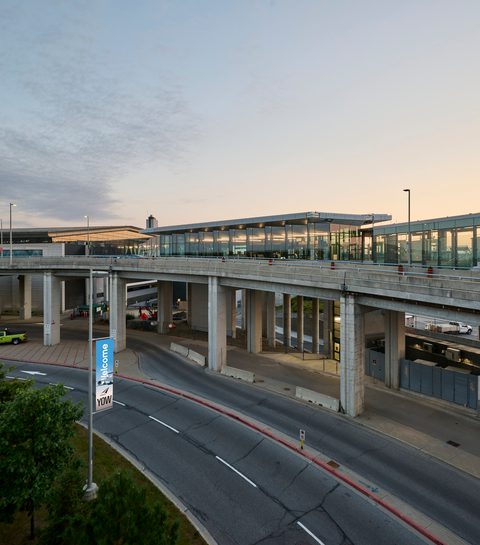Airport Improvement Fee increase


Overview
The Airport Improvement Fee [“AIF”] is a passenger fee set by each airport, collected by the air carriers on the airport’s behalf, and remitted to the Authority on a monthly basis. The last increase by YOW to the AIF was in 2014. AIF funds are used for AIF capital infrastructure and debt service pursuant to the terms of the AIF Memorandum of Understanding with the signatory air carriers since May 1999.
Current Situation
The unprecedented circumstances of the COVID-19 pandemic have resulted in the following significant events:
- Erosion in the Authority’s financial performance
- Reductions in cash flows [2020 and in future years] and expected draws on credit facilities
- Non-compliance with Master Trust Indenture Debt Service Coverage Ratio
In April and May 2020, passenger and flight movements dropped 98% from prior-year levels with a long recovery cycle expected to recover to 2019 levels. In 2020, the Authority projects total passengers to be 60% lower than expected, with the resulting significant impact to revenue levels. While expenses and capital investments have experienced reductions, the considerable expense burden of supporting regulatory, safety, and security requirements in maintaining and operating this critical air infrastructure prevent the reduction of expenses to the same degree. Negative cash flows will be significant in the near term and will require accessing committed credit facilities.
Credit Facilities
The Authority’s credit facilities are robust enough to support the Authority through this event and the eventual recovery, as currently modelled. However, the Authority will be faced with incremental borrowings, either through maintaining the borrowings on the credit facility or replacing it with additional debt. Another consideration resulting from the pandemic is that the Authority will not be able to generate the cash flows that it had expected to generate over the next 5-8 years. As a result, this deficit in cash flow generation is not just a 2020 impact but will instead be a cumulative impact on the Authority. This cash flow generation is essential because it funds airport operations, capital investment, and debt service. Once the opportunity to generate cash flows has been lost, it is a permanent loss. While the Authority has reduced operating expenses and capital investment, the cumulative losses of these cash flows are significant and must be considered in the overall recovery plan and as passenger and flight volumes recover.
Over the next 18 months, the Authority expects to draw approximately $40-60 million from its credit facilities. Modelling of downside risk has suggested that this credit facility draw could be higher and closer to $80 million if the recovery is slower and more drawn out than currently modelled. This event is not just a 2020 event. The recovery will be a long tail event with the current outlook suggesting that it will take until 2025-2026 to return to 2019 passenger levels.
Capital Spending
The Authority had planned to spend $48 million in capital investment in 2020. At the moment, the Authority has pulled back on most projects and reduced its planned spending to between $16 million and $20 million. For 2021 through to 2024, the Authority has place-held $15 million per year in capital infrastructure for a total of approximately $80 million, and which compares to the planned expenditure of $170 million as outlined in the 2020-2024 Business Plan. Major activities and projects have been deferred and postponed. The $15 million/year pace of spending should be considered optimistically low as there will be pressure to increase that investment level given the airport’s aging infrastructure, especially as volumes return and put pressure on it. With the significant reduction in passenger levels, the generation of AIF revenues used for all AIF capital infrastructure and related debt service has been significantly impacted and will continue to be much lower throughout the recovery period.
Debt Covenants
An additional factor to consider is compliance with debt covenants as outlined in the Master Trust Indenture [“MTI”]. The MTI is the debtholder agreement outlining the terms and structure of the Authorities debt holdings. The MTI includes several covenants that the Authority needs to comply with as part of its agreement with bondholders. There are two critical covenants; the first is the Debt Service Coverage Ratio [“DSCR”], and the second is the Gross Debt Service Coverage Ratio [“GDSCR”].
Both of these ratios represent the Authority’s ability to generate earnings that allow for the debt service [interest and capital repayment] on existing debt. The DSCR is a simple measure of Earnings Before Interest, Taxes and Amortization [“EBITDA”]. The requirement is that the Authority must have a ratio that meets or exceeds 1.00. In other words, the Authority must generate sufficient EBITDA to meet its debt service commitments on a 1:1 ratio. The GDSCR provides a broader view of the ratio by allowing the inclusion of the unused portion of the credit facilities. The ratio must meet or exceed 1.25. The GDSCR is the most important ratio as non-compliance can lead to an Event of Default [after a 12-24 month cure period]. An Event of Default is a serious event where, upon default, bondholders may take control of the airport. Because of the solid credit facilities, the GDSCR is substantially over the 1.25 and non compliance is not considered a risk at this time.
In 2020, the Authority will experience a significant deterioration of its financial position, including earnings. Accordingly, the DSCR will fall below the 1.0 requirement. We expect the DSCR to be in the range of 0.3 to 0.4, as currently modelled. Non-compliance with this measure does not lead to an Event of Default but does require an action plan to remediate over a reasonable time. For 2021, current modelling suggests that the DSCR ratio will be in the 0.7-0.8 range and represents a shortfall in earnings of approximately $8-10 million. The Authority has been provided the ability to increase rates and charges as needed. The MTI also references this foundational element, which is relied upon for credit quality from bondholders, rating agencies, and the investment community. It is expected to be used as part of a remediation strategy if required. We would also reinforce that it is a requirement that the Authority be compliant on all of its covenants to access debt markets.
Increase in AIF
Given the erosion in cash flows and financial position, and the need to position the Authority to maintain the ability to invest appropriately in its capital infrastructure as well as provide access to the debt market, the Authority is proposing to increase the AIF in 2020.
This conclusion is not taken lightly, and the Authority has considered a number of elements to balance the need to recover from the negative operating cash flows, replace lost cash flow, ensure financial sustainability going forward, and provide the ongoing cash flows to service long-term debt obligations through the recovery as follows:
- Federal Government support options: The Federal Government has guided airport authorities to leverage existing banking arrangements. These arrangements can lead to much better terms than those offered by the announced Federal Government support options. Nevertheless, borrowing options all require repayment plans that require additional cash flows.
- Bond Market: Investment bankers continue to reinforce that airport credit continues to be favourable. The Authority needs to be compliant with all covenants to access the bond market and present an outlook of the recovery that meets debtholder expectations. Any debt will need to be repaid through incremental cash flows and do not resolve the current challenges with the expected deficits and reductions in cash flows through the recovery.
- Other Debt Solutions: The Authority is reviewing the viability of alternative debt solutions with its investment banker community. There are significant barriers at the moment. These solutions continue to involve additional forms of debt that will need to be repaid with additional cash flows and do not resolve the current challenges with the expected deficits and reductions in operating cash flows through the recovery.
- Defer increase to 2021 and beyond: The Authority has experienced significant negative impacts on its financial and cash performance in 2020, including the consumption of all available cash balances. The Authority believes it is prudent to act on this proposal sooner than later to recover some of the eroded cash flows, provide incremental cash flows, ensure access to the debt markets as required in 2021/2022, and ensure that the Authority is proactive in protecting itself against a longer and deeper recovery if that were to happen.
- Wait until the federal government pronounces a decision on support measures: The Authority believes that it is not prudent to wait for any announcement as the government has, to date, avoided industry-specific solutions and has guided to general solutions available to broad cross-sections of industries. If and when the Federal Government were to announce a program with significant financial and cash flow benefit, the Authority would reconsider and readjust the outlook and impact on fee structures.
The Authority is proposing to increase the AIF by $5.00, from $23.00 to $28.00, effective October 1st, 2020. This fee applies to departing O&D passengers (connecting passengers do not pay this fee). The Authority last increased this fee in 2014. The $5.00 increase represents a 21% increase and is expected to generate an additional $7 million in AIF revenues in 2021 at a flight/movement level consistent with 3 million passengers and load factors in the range of 60-70%. The Authority will continue to have one of the lowest AIF amongst Tier 1 airports, with only Toronto and Vancouver being lower at $25.00.
